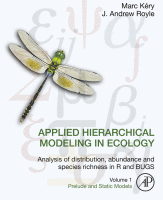Browse content
Table of contents
Actions for selected chapters
- Full text access
- Book chapterNo access
Summary and Conclusion
Pages 729-735 - Book chapterNo access
References
Pages 737-760 - Book chapterNo access
Author Index
Pages 761-770 - Book chapterNo access
Subject Index
Pages 771-783
About the book
Description
Applied Hierarchical Modeling in Ecology: Distribution, Abundance, Species Richness offers a new synthesis of the state-of-the-art of hierarchical models for plant and animal distribution, abundance, and community characteristics such as species richness using data collected in metapopulation designs. These types of data are extremely widespread in ecology and its applications in such areas as biodiversity monitoring and fisheries and wildlife management.
This first volume explains static models/procedures in the context of hierarchical models that collectively represent a unified approach to ecological research, taking the reader from design, through data collection, and into analyses using a very powerful class of models. Applied Hierarchical Modeling in Ecology, Volume 1 serves as an indispensable manual for practicing field biologists, and as a graduate-level text for students in ecology, conservation biology, fisheries/wildlife management, and related fields.
Applied Hierarchical Modeling in Ecology: Distribution, Abundance, Species Richness offers a new synthesis of the state-of-the-art of hierarchical models for plant and animal distribution, abundance, and community characteristics such as species richness using data collected in metapopulation designs. These types of data are extremely widespread in ecology and its applications in such areas as biodiversity monitoring and fisheries and wildlife management.
This first volume explains static models/procedures in the context of hierarchical models that collectively represent a unified approach to ecological research, taking the reader from design, through data collection, and into analyses using a very powerful class of models. Applied Hierarchical Modeling in Ecology, Volume 1 serves as an indispensable manual for practicing field biologists, and as a graduate-level text for students in ecology, conservation biology, fisheries/wildlife management, and related fields.
Key Features
- Provides a synthesis of important classes of models about distribution, abundance, and species richness while accommodating imperfect detection
- Presents models and methods for identifying unmarked individuals and species
- Written in a step-by-step approach accessible to non-statisticians and provides fully worked examples that serve as a template for readers' analyses
- Includes companion website containing data sets, code, solutions to exercises, and further information
- Provides a synthesis of important classes of models about distribution, abundance, and species richness while accommodating imperfect detection
- Presents models and methods for identifying unmarked individuals and species
- Written in a step-by-step approach accessible to non-statisticians and provides fully worked examples that serve as a template for readers' analyses
- Includes companion website containing data sets, code, solutions to exercises, and further information
Details
ISBN
978-0-12-801378-6
Language
English
Published
2015
Copyright
Copyright © 2016 Elsevier Inc. All rights reserved.
Imprint
Academic Press
